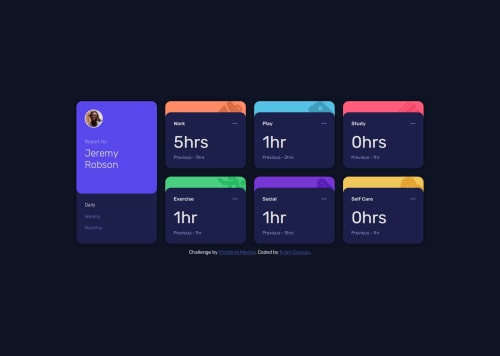Time tracking dashboard with typing animation

Solution retrospective
I'm proud of going a bit above and beyond for this solution. Initially, I was thinking of just completing it regularly, but I want to be able to grow from the projects I create on here, so I decided to add a typing animation. It's not much, but it's setting the precedent for my projects to come.
What challenges did you encounter, and how did you overcome them?The typing animation whenever a timeframe button was pressed caused the most trouble for this project. Whenever I was first watching tutorials about HTML/CSS/JS, they used the concept of namespaces for declaring elements, and using that concept turned out to be beneficial when selecting the elements for the typing animation.
However, I had a bit of trouble editing the text for the animation, since originally I was editing the innerText property of each element, but the typing cursors for the animation was contained inside each element that I was editing. If I changed the innerText of 1hr|, so that it said "2hrs" instead it resulted in 2hrs and the span getting overridden. I overcame this by recalling the concept of the DOM tree from the tutorials I watched -- I updated the text node (e.g. paragraphElement.childrenNode[0].nodeValue) instead of the innerText.
I'm gonna try to incorporate these concepts more in my future frontend projects, and apply more structure to my code so that I can improve the readability as well.
Please log in to post a comment
Log in with GitHubCommunity feedback
No feedback yet. Be the first to give feedback on Kylan Duncan's solution.
Join our Discord community
Join thousands of Frontend Mentor community members taking the challenges, sharing resources, helping each other, and chatting about all things front-end!
Join our Discord